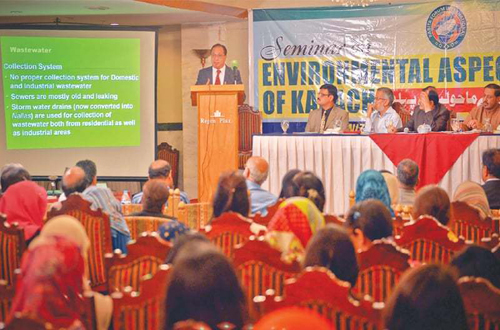On Tuesday, 10th March, 2015, at “Regent Plaza”, Karachi.
SPEAKERS
1. Mr. Muzaffar Shujra 2. Mr. Nusrat Mirza 3. Dr. Mashiatullah 4. Mr. Naeem Mughal 5. Prof. Dr. Waqar Ahmed 6. Mr. Zafar Imam Advocate
No major threat by nuclear power plants to environment says research group
“The term of nuclear power plant seems threatening, giving rise to various myths about its operation and utilisation, but in fact nuclear power plants produce little waste and unlike popular perception are not a threat to the environment,” said head of an environmental research group PINSTECH Azhar Mashiatullah while presenting his case on the nuclear power versus green option debate on Tuesday.
Organized by a group named Rabita Forum International to discuss the ‘environmental aspects of Karachi’, the seminar came at a time when the debate on generating power through nuclear reactors is gaining momentum with some strong voices pointing out its long-term negative impact on the environment.
Continuing with his presentation, Mr. Mashiatullah argued that worldwide generating power through nuclear reactors is “seen as a viable option”. Citing the case of Germany, he said: “Having a strict, one-sided opinion about the nuclear reactors, Germany had to change and yield to the energy demands in its country by striking out a nuclear power plant deal with Japan.”
Mr. Mashiatullah explained that at present 31 countries were generating power through nuclear reactors and that 26 nuclear reactors were under construction in China alone. “We have been hearing a lot about the debate on K2 and K3 projects to be built near Kanupp. The problem is, many people don’t understand Karachi’s energy crisis and assume things on their own. What are the chances that the nuclear reactor built near Kanupp will be mismanaged? I, for one, don’t think so.”
Sindh Environmental Protection Agency director general Naeem Ahmed Mughal said waste from the industrial areas being dumped in the sea was causing a lot of problems. He said Karachi’s biggest issue was its unplanned expansion. “The industries don’t understand that it’s their responsibility not to let untreated waste flow into the sea. And even if an action has to be taken against them, which department should we go to? There are not one but various agencies, owning land and waste disposal in Karachi. And lack of coordination among them is what has kept the situation stagnant for so long,” said Mr Mughal.
The Sepa director-general, however, did not touch the nuclear reactor debate and his organisation role in the current situation. Instead he continued to speak about the many “ills of Karachi” one of which he said was the underfunded agencies. He also complained that the higher authorities were not ready to solve what he called interconnected problems on a priority basis. Waqar Ahmed, assistant professor at the Institute of Environmental Studies, spoke about the destruction caused to Karachi by some “big organisations”. For instance, he said: “Over the years, the Defence Housing Authority is found to be involved in cutting mangroves to make space for plots in its place. It’s happening in broad daylight and there’s not a single organisation to raise objection to this blatant destruction of a natural resource.”
He said lack of mangroves meant shrinking space for nesting areas for birds of all types. Giving an example of Ibrahim Hyderi, he said the water near the old harbour, known for fishing, had become a dumping ground for textile industry waste.
Summing it up, he said that pollution, population, habitat destruction and depletion of resources were interconnected issues which would continue to come up whenever a discussion on environment would take place.
Published in Dawn, March 11th, 2015


